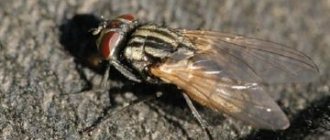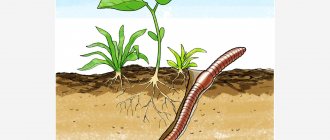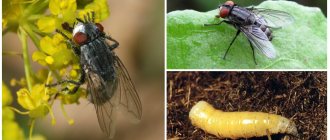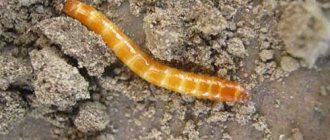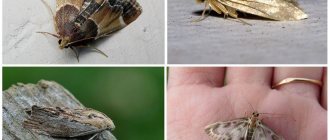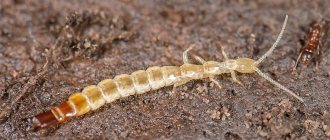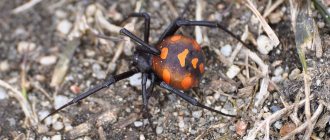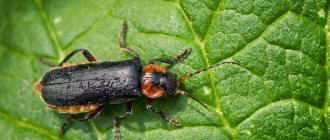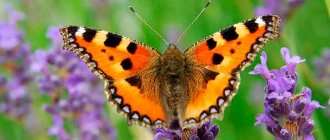Appearance of blow flies
The large family includes 106 genera, 3 subfamilies. Externally they differ in size and color. Corpse flies that live on our territory are practically no different in appearance from indoor and household pests.
- Body length from 5 to 25 mm. The average size of a blowfly is 20 mm.
- The color is gray with stripes, a checkerboard pattern, and black spots. Or shiny with tints of blue, green, yellow. Glistens beautifully in the sun.
- The eyes are large and bright red.
- The wings are transparent, slightly set aside.
A photo of a blowfly is shown below. The most common types in our area are gray, blue, and green.
On a note!
The larvae of meat scavengers come in two types: smooth and hairy. They have the shape of a worm, about 15 mm in length. The smooth “cubs” feed on the juices of corpse meat, the hairy ones are predators, eat the first ones, and always appear on the corpse a little later.
Viviparous flies give birth to miniature white larvae - maggots. Other species of this family lay eggs. Round, yellowish in color, no more than 1 mm in size. They are located in groups. The worms go through three molts and gradually increase in size. At the last stage, the worms burrow into the soil, pupate, and emerge as adults. The entire development cycle from egg to adult takes 11 days under favorable conditions.
What happens if you eat a fly larva
When exposed to light they are very small - no more than 1 mm. They feed intensively, grow quickly and become noticeable within 2-3 days. The situation when a person has eaten maggots occurs quite often in everyday life. Nobody really thinks about it, but if you start to figure it out, nothing bad will happen.
The fly larva, despite its unattractive appearance, brings benefits with its presence. Maggots secrete substances that are superior to powerful antibiotics. Being in an unfavorable environment, they are not exposed to pathogens and contribute to their destruction.
On a note!
Maggot itself is a pure protein that will benefit a person. However, to feel the beneficial effects, you need to purposefully eat a single worm. In some countries they do this, which is not typical for our area. If you accidentally swallow a larva, there will be no harm to the body; you need to worry more about what food got inside, since there were already larvae there.
Myases
Serious diseases are caused by gray larvae. Eggs enter the body with food, in the presence of diseases of the digestive tract, weak immunity, they are not digested and enter the systemic bloodstream. Over time, they are localized in different internal organs.
The larvae never pass through the human body, but during their life activity they can cause significant harm. Swallowing eggs due to their small size is quite easy, so you need to pay special attention to where you eat, the quality of the food, and eat only fresh foods. Eggs are laid only on products that begin to deteriorate or storage conditions are violated.
There are more than one hundred and fifty thousand species in the world. And only a few of them are carriers of infection, while most are quite harmless, like butterflies. So which flies should you be wary of? And why are some of them so partial to carrion? Why do some people prefer flowers and fruits?
What is myiasis
These are parasitic diseases that occur when insect larvae penetrate the skin and develop there. Typically these insects are flies. They are most often found in South America and Africa. In Russia, Kazakhstan, and the Caucasus, flies can cause entomosis. Myiases can be superficial or deep. The causes of the former are the larvae of house flies, house flies, and blow flies. Eggs are laid on wounds, abrasions, mucous membranes of the nose, eyes, and genitals. Symptoms manifest themselves in the form of itching and an unpleasant sensation - as if goosebumps are crawling. This type of disease is benign. The larvae feed on pus and decomposed tissues.
Deep myiasis causes more serious consequences. The causative agent of the disease is Wohlfart flies from the genus Wohlfortia and Chrisomyia. They can lay their eggs in places where purulent skin lesions are located. The emerging larvae penetrate deep into the skin, destroying tissue. In case of severe illness, the temperature rises, headache, and weakness appear. If the larvae are on the conjunctiva, they eat away the mucous membrane of the nose, oral cavity, and sometimes even bones and cartilage.
Intestinal myiases.
Whatever the fly, be it a meat fly, a cheese fly, or a house fly, its larva can cause myiasis. The essence of this phenomenon is that maggots develop in the human body, delivering a full range of symptoms of gastrointestinal disease: nausea, vomiting, diarrhea, abdominal pain and weight loss. This process usually occurs in an acute form, but if treatment is taken in a timely manner, the prognosis is quite favorable.
Habitat
Gray blowflies are distributed throughout the world, but their largest populations are found in the European part of Russia, the Caucasus, Central Asia and Siberia.
Blowflies can be found anywhere where they can gain access to quickly decomposing organic matter: in garbage dumps, in country and street toilets, in markets with open food storage, especially in meat aisles. Also, flies do not bypass hospitals in places of military operations.
When flying in search of a suitable place, flies on average can travel up to ten kilometers in their lives.
Reproduction
Females of gray blowflies are viviparous, which gives them an undoubted competitive advantage over other species. Flies lay larvae on meat, fish, waste, rotting fruit, in a word, on any decaying organic matter, including wounds on living creatures, which after the appearance of the larvae turn into ulcers.
It is enough for the female to touch the selected place with her abdomen for a moment for the larvae to be born and immediately begin to crawl and bite into the meat.
The place of penetration of the larvae is easy to track, since under the influence of the juice produced by the larvae, the meat begins to quickly decompose, releasing liquid and disintegrating.
The larvae feed on this “broth” and particles of meat, as they prefer an already digested product.
The larvae do not neglect living creatures either, eating the insides of grasshopper larvae, beetles, snails and caterpillars.
After feeding for five days, the larvae move underground and pupate, falling into a long hibernation, sometimes lasting for months. Sometimes the pupae even overwinter, and the hatched flies emerge from the ground only in early spring.
It is interesting how adult flies come to the surface, since the body structure of an adult is not designed for digging. But gray flies have found an interesting way: between their eyes they have a frontal bubble, which, when inflated, increases several times and pushes the ground.
Adult blow flies, which live only a week, spend most of their time on flowers, pollinating them, and looking for a place to lay the larvae of future offspring.
Real flies
Representatives of the family (and there are over 3000 species) feed on plant sap; there are saprophages, predators; some species are bloodsuckers (females, sometimes males). The larvae of true flies are predators or saprophages, and extremely rarely they are parasites of locusts or ectoparasites of birds. They develop in decaying organic debris, sometimes in living tissues of plants or animals.
Housefly Musca domestica
The housefly is an insect of the family of true flies, a common synanthropic organism, practically no longer found in the wild. The housefly is an ancient companion of man; paleontologists find imprints of its wings in the deposits of late Neolithic human sites.
The flies have a licking-sucking mouthparts, and house flies are not capable of biting through the skin and drinking blood, unlike similar autumn flies. Flies can only absorb liquid food; to consume solid food, they first dissolve it in saliva.
With its legs, a housefly can touch and smell objects and taste them. On any surface - smooth, steep - it will find something to cling to, because the hairs on its paws are impregnated with a special secretion that ensures their adhesion to the material.
The eyes of a fly are an amazing optical apparatus that can also process chemical, electrical and tactile signals. These huge compound eyes are made up of 3,000 individual ocelli, ommatidia. Flies have all-round vision; they can even look back... The housefly has amazing fertility.
Its entire development cycle takes place in just two weeks, and scientists have calculated that in one summer a pair of houseflies can produce offspring weighing 80 thousand tons.
Family Gray blowflies Sarcophagidae
This family has about 2,600 species distributed throughout the world, with about 300 in Russia alone. Their scientific name (from the Greek σαρκο- - flesh, meat and φάγος - eater) indicates their habit of reproducing on the corpses of vertebrate animals.
These dipterans can be confused with the common housefly, but blowflies are larger and reach a length of 10-25 mm (although species only 5-10 mm long are found). Their body is most often painted in ash-gray tones with black spots, stripes or a checkerboard pattern; the eyes are usually bright red.
Female blow flies are viviparous. Larvae of various species of blowflies are found not only on decaying meat and carrion, but also on rotting fruit, feces, manure and other decaying organic matter. Among them are parasites of insects and mollusks. Blowfly larvae are characterized by extraintestinal digestion.
Occasionally they eat the larvae of other flies, as well as the larvae of grasshoppers, beetles, snails and caterpillars. The larvae spend 5-10 days on the meat, after which they move to the soil, where they pupate and turn into adult flies.
Blowfly pupae are capable of hibernating for a long time; Thus, the larvae of some Sarcophaga species hibernate in the fall and only turn into adult flies in late spring. Adult blow flies can be found on flowers, feeding on nectar.
Their body is strewn with numerous long bristles, to which pollen easily sticks - thus the flies act as pollinators. Adult flies live 5-7 days.
Blowflies are carriers of pathogens of some infectious diseases, but, on the other hand, by destroying carrion, they play an important role as nature’s orderlies. The life cycle of blowflies has been well studied, so the presence of their larvae on corpses makes it possible to determine the time of death, which is successfully used in forensic science.
Carrion or gray blowfly Sarcophaga carnaria
The gray blowfly reaches a length of 10-14 mm and is almost twice the size of a housefly. It is gray in color, has a yellowish-white head with a black stripe in the middle. Her eyes are red, there are longitudinal light stripes on her chest; the oblong, segmented abdomen is covered with large setae; legs are shaggy, covered with hairs.
This fly rarely flies into houses, but very quickly detects corpses. It is enough for an insect to touch the surface of the meat with its abdomen, and a bunch of tiny worms are already moving on it, which quickly crawl in different directions and penetrate into the tissue.
In the place where they found their refuge, the meat soon begins to get wet, liquefy, and soon the larvae find themselves immersed in liquid. The reason for this phenomenon is also the juice secreted by the larvae, which contains a substance that acts on meat proteins like pepsin.
Each female can produce up to 20,000 larvae, which she discards and places in small batches of 10-12, searching for corpses and returning to the same corpse many times.
At the anterior, pointed end of the larva there are 2 oral hooks; the posterior, truncated end has a cup-shaped notch, at the bottom of which there is a pair of respiratory plates in the form of two rusty points.
When breathing, the larva exposes its rear end from the liquid, and the edges of the cup-shaped recess adhere to the surface of the liquid due to its surface tension. Thus, the larva breathes while hanging upside down and is not in danger of drowning.
Having reached maximum growth, sarcophagi larvae leave the corpse and bury themselves in the ground to a depth of 8-10 cm. There they pupate. After some time, young flies emerge from the cocoons and make their way to the surface of the earth.
The method by which flies hatched underground emerge to the surface is remarkably interesting. Their legs are unsuitable for tearing up the earth, and so are their mouthparts. The hatched fly has a huge frontal bubble on its head between the eyes, which is two or three times the size of the head itself. When inflated, the elastic bubble pushes away soil particles. Then the bubble collapses, and the fly occupies the cavity where the bubble was. A new pulsation of the bubble - and a new step forward. In this way, moving forward with the help of this apparatus, the newborn fly leaves the ground; the frontal bladder is finally retracted; the fly cleans itself, rests and takes off.
Source: https://zoogalaktika.ru/photos/invertebrata/arthropoda/insecta/diptera/muscidae
Harm
Now let's talk about the harm a blowfly can cause to humans. In addition to the fact that they are unpleasant when they appear near a home, they are also capable of carrying diseases dangerous to humans. The most terrible of them is leprosy, or leprosy. But this, of course, is very rare in our time, but an upset gastrointestinal tract will not give us pleasant sensations.
In addition, blowflies can lay larvae on fresh and even lightly salted foods. Thus, the blowfly harms the same fishermen who hang out not completely salted fish for drying.
Flies also annoy our pets. They also carry their diseases by feeding on the corpses of dead animals.
Meaning and harm
All types of blowflies pose an epidemiological danger, as they are mechanical carriers of many dangerous infectious diseases. These include viral, bacterial, and parasitic diseases.
The most terrible disease carried by flies is leprosy (the old name is leprosy), the most common are intestinal infections.
All infections are transmitted due to the contact of insects alternately with places of old and fresh contamination with feces, and then with food and household items.
Fly larvae are harmful as causative agents of myiases (parasitic diseases) in humans and animals. Green flies in countries with a humid, warm climate (Holland, Australia, Great Britain) can cause the death of newborn lambs. Adult females lay larvae on sheep's wool and in open wounds, the latter burrow under the skin and corrode the animal's tissues. They are attracted by the smell of rotting wool and fungal skin diseases.
Many flies cause significant damage to fisheries because they lay larvae in lightly salted and fresh fish. After which it loses its commercial properties.
However, blowflies also have a positive impact on the environment. They are nature's orderlies, destroying carrion and rotting organic waste.
If chickens become infected with chicken mites, then their egg production decreases and their immunity decreases. The tsetse fly is a carrier of sleeping sickness, which can kill a person within a few days. Read the article about how humanity fought this insect.
There are many types of ants in the world. Which of them are the most common, read the link.
Gray blowfly
This fly is also called a sarcophagus. She is carrion. This is a large fly, its length reaches 25 millimeters. Gray blowflies are, as the name implies, gray in color with a darker checkered or line pattern, with a yellowish-white head “divided” by a black stripe. The eyes are red, and there are white longitudinal lines on the belly. The body shape is oblong, the abdomen is covered with large bristles, and the legs are shaggy.
Gray blowflies are rare guests in a human home and appear there only if they have something to profit from there. The sense of smell of these flies is very developed, and they are able to smell the smell of rotting meat at a very long distance. Moreover, they only need to touch the surface of the meat for many small worms to immediately begin to move on it.
Female gray blowflies are viviparous and lay their larvae primarily in carrion. But there are representatives of this family, the larva of which is capable of developing in rotting fruit, feces or other decomposing organic matter. There are also types of flies whose larvae are capable of parasitizing other living organisms.
The larva of this fly is characterized by extraintestinal digestion. Sometimes she is able to feed on the larvae of other insects or practice cannibalism. The blowfly larva lives on carrion for up to 10 days, after which it moves into the soil, where it turns into a pupa, and then into an adult fly.
The pupa of a blowfly can hibernate; for example, the pupae of some species of sarcophagus are able to “sleep” through the entire winter and turn into an adult only in late spring.
The blowfly feeds on the nectar of flowers, and at the same time pollinates them, carrying pollen on its shaggy legs.
The attitude towards gray blowflies, as well as other carrion species, cannot be unambiguous. Being carriers of infectious diseases, they also serve as a kind of orderlies in nature. And forensic criminologists are able to determine the time of death by the age of the larvae in a decomposing corpse.
Description of the insect
Larva
Blowfly larvae are worms 8–15 mm long, usually white or cream in color. The anterior end of the body is pointed and has a pair of oral hooks. At the posterior truncated end there is a bowl-shaped recess that contains respiratory plates - two points of a dirty red color.
The development of the larva lasts 5–10 days, after which it burrows into the soil to a depth of 9–11 cm for pupation. Subsequently, adults emerge from the cocoons.
The method of emerging from the ground is very original. The fly inflates a very large bubble on its head in the forehead area; it is 2-3 times larger than the head. While the bubble is inflated, it pushes away grains of soil. Then it deflates and the fly moves to a cleared place, after which the bubble is inflated again. And so on until the adult is outside, then the bubble is completely retracted.
Doll
It has an oval or oblong shape, the color of the cocoon is black, dark brown or brown with a reddish tint. The thoracic spiracles are located on the border between the first and second abdominal segments.
Adult
Blow flies are quite large in size compared to ordinary house flies.
Their body length can reach from 8 to 20 mm. Body color depends on the species.
Common features include bristles covering the entire body and huge, round, compound eyes that are usually red or dark red in color. All have a pair of membranous wings and ground beetles transformed from the hind wings. On a rather large head there is an oral apparatus - a proboscis, designed for licking and sucking liquid food.
They use their eyesight to survive. Therefore, the eyes have a very complex structure and detect any slightest movement. Some varieties have three-dimensional vision.
The life cycle of an adult lasts from 5 to 7 days.
Reproduction
Blow flies are viviparous species. The fertilized female finds a decomposing corpse and sits on it, touching the surface with her abdomen. Almost immediately, larvae appear, which are very mobile and quickly penetrate the tissue. In the habitats of the larvae, the meat quickly becomes soggy and liquefied. This occurs due to the secretion of liquid by the larvae with a substance that affects proteins, like pepsin.
One fertilized female is capable of producing a huge number of larvae (up to 20,000), placing them in small groups.
What do larvae and adult flies eat?
Larvae and adults feed on the meat of decaying animals, carrion, rotting fruit and any other organic matter in the process of decomposition. In addition, the larvae eat beetle and grasshopper larvae, other flies, snails and caterpillars. They have extraintestinal digestion.
Green blowfly
This is a beautiful fly of a glossy emerald color with smoky wings that have a faint openwork pattern. The length of the green fly usually does not exceed 8 mm. It has large reddish eyes, a rounded belly and white cheeks.
The habitat of the green blowfly is places of all kinds of sewage, decomposing animal corpses, manure, waste, but sometimes they are also found in flowering plants that have a strong aroma. The food consists of rotting organic matter, where it lays its eggs.
One female is capable of laying approximately 180 grayish or light yellow eggs, which she tries to hide in carrion as deep as possible. The larvae are born after 6-48 hours and continue to develop there for another 9 days. They then move into the soil to develop into a pupa. Depending on weather conditions, an adult fly is formed within 10-17 days.
Blue carrion fly
Calliphora vicina also has other names:
- red-headed blue carrion;
- blue blowfly;
- red-headed;
- red headed blue fly.
This species was once very important in medieval healing. Today, the method of cleansing wounds using maggots is again gaining popularity. In modern medicine, blue blowfly maggots are also used to sterilize wounds and prevent necrosis. But now they are grown in sterile conditions.
Body length 5-14 mm. The dark blue belly is covered with bristles. The female lays up to 300 eggs and is capable of producing 5 generations during her life. Offspring are laid on fresh corpses or open wounds. The development cycle at 27°C takes 18 days.
Benefits of blue flies
Doctors discovered several groups of active pharmacological substances in the larvae’s immune system. They serve as a source for drugs that are used to combat infectious diseases and cancer.
Interesting!
At the beginning of the last century, an American surgeon described an interesting case. 2 soldiers were admitted to the hospital with wounds and fractures. They were without water and food for a week (before they were taken to the hospital). With this condition, a high temperature is usually observed, indicating blood poisoning. The mortality rate is high - up to 75%, if medical assistance is not provided in time. The soldiers had no such symptoms. When their clothes were removed, large numbers of blowfly larvae were found in the wounds. After the affected areas were disinfected, streptococci and staphylococci were discovered. But their number was not enough to fester.
This question has not been fully studied. But the topic is interesting for doctors. To heal wounds that do not heal quickly, today larvae are specially bred in laboratories. But flies that surround a person in his daily life, unlike laboratory specimens, can cause significant harm to a person.
How dangerous are gray blowflies?
Since the main habitats of blow flies are garbage dumps and other places with decaying garbage, it is not surprising that these insects are carriers of a whole type of disease, ranging from gastrointestinal disorders to typhoid fever and cholera .
The larvae are dangerous because when they get on the mucous membranes and wounds of humans and domestic animals, they contribute to the development of ulcers and provoke blood poisoning.
Larva
The larva of the gray blowfly reaches 2-3 millimeters. It differs from most larvae of other species in that its rear part is equipped with a respiratory recess in the form of a cup with special valve plates.
This extravagant arrangement of the spiracles provides the larva with the opportunity to dive into liquids and grab onto meat with its mouth hooks, without fear of suffocation, since the back part is exposed to the air. An interesting effect can be observed from the accumulation of many feeding larvae: their exposed and moving spiracles resemble sea anemones.
Similarities and differences
Both families of dipterans belong to corpse flies. But if meat products only cause harm to a living person, then carrion maggots are used to clean wound surfaces from dead tissue.
There are more similarities between the families than you might think:
- some species can reproduce in both meat and feces;
- some species switched to parasitizing living mammals (Wolfartova in Europe and Lucilia cuprina in Australia parasitize sheep);
- Adults feed on flower nectar.
Also, the larvae of flies on meat can belong to species from both families.
Protection measures
The most successful in getting rid of flies can be considered those activities that are aimed at cleaning standard insect habitats:
- continuous removal and destruction of waste on an industrial scale;
- neutralization of liquid waste in sewerage basins or cesspools;
- maintaining cleanliness in places where meat and fish products are sold;
- timely removal of household waste;
- destruction of larvae and pupae with chemicals in suspicious places;
- installation of mosquito nets on windows;
- washing hands before eating.
